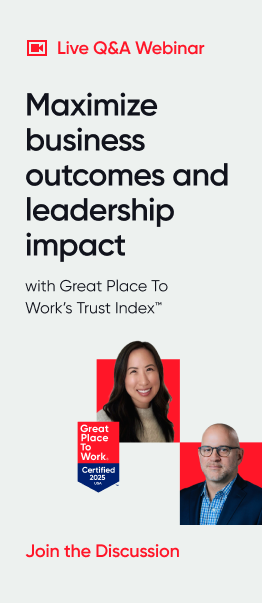Diversity & Inclusion, High-trust leadership, Remote & Hybrid Culture
Ready or not, hybrid work is here to stay. Our research has found that three out of five Fortune 500 executives believe that up to 25% of their workforce will continue to work remotely full-time post-pandemic.
Employee surveys Great Place To Work® gathered throughout 2020 and into May 2021 reveal the same. Words such as “hybrid,” “flexibility,” and “remote” were mentioned by more than 53,000 employees when asked what they like about their workplace or what could make their workplace better.
The sentiment is clear: the days of all employees being together in an office are over.
“Going forward, place shouldn’t matter, but flexibility should,” says Great Place To Work’s CEO, Michael C. Bush. “I don’t think of the hybrid future as one of physical space. I think of it as really caring for people and giving them the flexibility that’s needed to have a high sense of well-being.”
But as we move into this new era of hybrid work, the future of how we’ll work is yet to be determined. How do companies define flexibility? What do employees want from the modern workplace? And why are some companies resistant to this kind of change?
The ongoing Great Resignation has proven that employees aren’t afraid to walk away in search of something better. Which is why companies that listen, adapt and change will be the ones to succeed and build the foundation for a new hybrid workplace future.
What is hybrid work culture?
A hybrid work model is one in which employees are split between in-office and remote locations. The arrangement may mean that only some essential employees are required to work on-site while others can work remotely, or it may be that all employees are given the freedom and flexibility to choose their work location and schedule.
But a successful hybrid work culture is about much more than just establishing a model around hours and location. Hybrid work culture is the combination of workplace systems, behaviors and values that cut across in-person and remote teams and impacting overall employee experience. Hybrid work culture is how you bring the different ways people work together.
To succeed, a hybrid workplace must equally consider the needs of in-person employees and remote employees and set up an arrangement that benefits all.
Here are 5 ways hybrid workplaces and leaders are achieving hybrid success:
1. They trust their employees
For leaders who found their own success in an office setting, it can be hard to imagine a high-functioning remote or hybrid work model — even though research on remote productivity debunks this view.
Used to being the kings and queens of their office castles, it takes a humble leader to embrace being just another face on a screen.
Companies that have successfully implemented hybrid workplaces are willing to transition from a control style of leadership to a more modern, people-centric style — a style that trusts employees to get the job done form anywhere.
Computing company NVIDIA embodies this with a “the project is the boss” philosophy, in which it’s up to employees (and their schedules) to decide when work is completed, as long as the project gets done as expected.
2. They listen to their employees
One of the major challenges of remote/hybrid work is that it’s harder to build empathy with people when you’re not physically with them. As such, remote employees may feel like their co-workers and managers aren’t seeing their full selves or their full potential.
They are willing to transition from a control style of leadership to a more modern, people-centric style — a style that trusts employees to get the job done.
But remote/hybrid work also brings communication advantages. You can now bring together people who typically wouldn’t connect — those who are in different locations and time zones or living in different circumstances, for virtual conversations.
Successful hybrid leaders know that they need to take advantage of these opportunities while minimizing isolation.
To maintain employee trust and fairness, they pro-actively solicit employee feedback in real time, whether that’s through regular pulse surveys, feedback sessions, or another method.
At Wegmans, an open-door policy means that employees are always empowered to speak directly with their managers.
But the company goes a step above with its Open Door Day program, during which all leaders, from managers to HR to executives, dedicate one-on-one time with employees, to discuss any topic the employee chooses. Often, employees are accessing leaders two, three, or four levels above their direct supervisor.
3. They co-create with and empower their employees
According to a study by Slack, 75% of executives want to work in the office, compared to 34% of non-executives. Sadly, too many senior leaders aren’t willing to see the benefits of remote/hybrid work, nor are they willing to give employees a say.
Leading hybrid companies have the opposite attitude. They aren’t afraid to put their employees in the driver’s seat and make them co-creators of the new workplace.
By offering flexibility, these workplaces empower employees to prioritize their personal lives — thus increasing employee well-being, engagement and retention.
EY has created what it calls a Design Council, a team of employees spanning across functions, regions and rank, and selected based on their ability to act as change champions at all levels of the company. Together, the team used their diverse perspectives to create EY’s “Way of Working” guidance.
By offering flexibility, these workplaces empower employees to prioritize their personal lives — thus increasing employee well-being, engagement and retention.
Similarly, at Certified™ great place to work IBM, the company hosted a “Think Forward Jam” — a two-day virtual event for more than 34,000 employees to co-create recommendations, build ownership, and share best practices of how everyone could work together and transition to the new normal.
4. They create equity between remote and in-person employees
When employees are scattered, it’s far too easy to overlook those who don’t get as much face time with management. Successful hybrid leaders ensure that all employees are considered for projects and promotions, and keep track of all employees to ensure no one is left behind.
These leaders also recognize the unfairness often felt by those employees whose roles don’t permit them to work from anywhere. One of the major contributing factors to the Great Resignation is frontline workers seeking out roles that offer more flexibility.
To combat this, successful leaders ensure on-site workers are given comparable flexibility as their remote counterparts.
For example, Hilton redefined its on-property roles and implemented a new “SuperFlex” workforce model that allows call center staff to choose their schedule and number of work hours.
Successful leaders ensure on-site workers are given comparable flexibility as their remote counterparts.
5. They set clear intentions with their employees
Over the past couple of years, we’ve all learned that living in chronic uncertainty is exhausting.
As we embark on this new normal of hybrid work, it’s crucial for employers to provide clarity and consistency. This not only impacts productivity and employee engagement, but also the well-being of everyone at the organization.
Salesforce has done this with their Flex Team Agreements (FTAs), which outline how work gets done, covering everything from how workdays are scheduled, how meetings should run, and how to collaborate in a way that keeps everyone connected.
These FTAs are made up of three levels — company, function and team — thereby creating a consistent experience for all.
Want to be a successful hybrid leader?
Listening to your employees via regular employee surveys will ensure your transition to hybrid is a smooth and meaningful one. Contact us to learn how.












